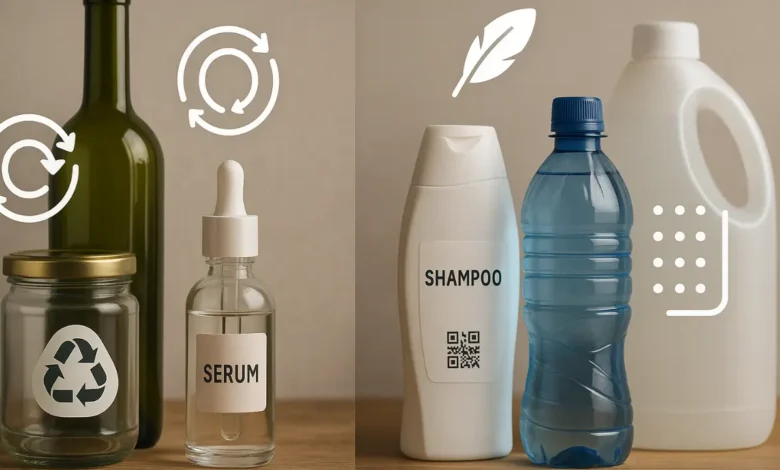Glass vs Plastic: The Packaging Materials Transforming Business

Packaging materials shape how products reach consumers and perform in the marketplace. Two powerhouse options—glass packaging and plastic bottle packaging—each bring distinct advantages that can elevate your brand and streamline operations. Rather than viewing these materials as competitors, smart businesses recognise their unique strengths and deploy them strategically.
Both materials have evolved far beyond their basic origins. Modern glass packaging offers premium appeal with cutting-edge functionality, whilst plastic bottle packaging delivers versatility with innovative sustainability features. Understanding these benefits helps businesses make informed decisions that align with their brand values and operational needs.
The packaging industry continues pushing boundaries with both materials, creating solutions that protect products better, reduce environmental impact, and enhance consumer experiences. Let’s explore how these materials can work for your business.
Glass Packaging: Premium Performance with Timeless Appeal
Glass packaging brings an inherent sophistication that elevates product perception instantly. This material excels in preserving product integrity—it’s completely non-reactive, meaning your contents maintain their original flavour, scent, and potency without interference.
Superior Product Protection
Glass creates an impermeable barrier against oxygen, moisture, and contaminants. This makes it exceptional for pharmaceuticals and cosmetics, where maintaining quality is paramount. The material’s stability ensures consistent product performance throughout shelf life.
Brand Positioning Advantages
Premium brands leverage glass packaging to communicate quality and craftsmanship. The weight and clarity signal value to consumers, supporting higher price points and brand loyalty. Glass packaging photographs beautifully for marketing materials, creating visual impact that plastic alternatives struggle to match.
Sustainability Credentials
Glass packaging offers genuine circular economy benefits. It’s 100% recyclable indefinitely without quality degradation, and recycled glass requires less energy to produce than virgin glass. Many businesses find glass aligns perfectly with sustainability commitments whilst maintaining premium positioning.
Plastic Bottle Packaging: Versatility Meets Innovation
Plastic bottle packaging delivers unmatched flexibility for diverse product requirements. Modern plastic formulations address specific industry needs whilst maintaining the material’s core advantages of durability and design freedom.
Operational Efficiency
Lightweight plastic reduces shipping costs significantly—a major consideration for businesses operating on tight margins. The material’s durability prevents breakage during transport and handling, reducing replacement costs and customer complaints.
Design Innovation
Plastic bottle packaging enables creative shapes, ergonomic designs, and functional features impossible with glass. Manufacturers can integrate measuring cups, spray mechanisms, or child-resistant closures directly into the packaging. This versatility supports product differentiation and enhanced user experiences.
Advanced Barrier Properties
Modern plastic formulations include barrier technologies that rival glass performance for many applications. Multilayer constructions and specialised additives create packaging that protects against light, oxygen, and moisture whilst maintaining the weight and safety advantages of plastic.
Innovation Driving Both Materials Forward
The packaging industry continuously develops new technologies that enhance both glass and plastic performance.
Glass Innovations
Lightweight glass formulations reduce shipping costs whilst maintaining durability. Surface treatments improve scratch resistance and enable new decoration techniques. Smart glass technologies even integrate with digital systems for authentication and consumer engagement.
Plastic Advances
Biodegradable plastic formulations address environmental concerns without sacrificing performance. Advanced recycling technologies create closed-loop systems for plastic bottle packaging. New barrier coatings and multilayer structures expand applications into previously glass-only territories.
Sustainability: Both Materials Evolving
Sustainability drives innovation across both material categories, creating opportunities for environmentally conscious businesses.
Glass Sustainability
Glass packaging excels in reusability and infinite recyclability. Local sourcing of recycled content reduces transport emissions. Energy-efficient manufacturing processes continuously reduce the carbon footprint of glass production.
Plastic Sustainability
Plant-based plastic formulations reduce dependence on fossil fuels. Chemical recycling technologies break down plastic bottle packaging into base components for new products. Lightweighting initiatives reduce material usage whilst maintaining performance standards.
Making Strategic Material Choices
Successful businesses consider multiple factors when selecting packaging materials. Product requirements, brand positioning, supply chain capabilities, and sustainability commitments all influence optimal choices.
Glass packaging suits products requiring maximum protection and premium positioning. Industries like cosmetics, pharmaceuticals, and craft beverages often find glass aligns with brand values and consumer expectations.
Plastic bottle packaging excels for products requiring lightweight, durable packaging with design flexibility. Personal care, cleaning products, and beverages benefit from plastic’s safety and functional advantages.
The Future of Packaging Materials
Both glass and plastic packaging continue evolving to meet changing business needs. Smart packaging technologies integrate sensors and digital features. Sustainable formulations address environmental concerns. Manufacturing innovations reduce costs whilst improving performance.
The packaging industry’s future lies not in choosing sides but in understanding how different materials serve different purposes. Glass packaging delivers premium appeal and maximum protection. Plastic bottle packaging offers versatility and operational efficiency.
Businesses succeed by matching material properties to specific requirements rather than following trends. The best packaging decisions consider product characteristics, brand goals, and operational constraints together.
Both materials offer compelling advantages for modern businesses. Understanding their strengths enables better decisions that support product success, brand building, and sustainable operations. The packaging industry continues innovating with both materials, creating new opportunities for businesses ready to leverage their unique benefits.




